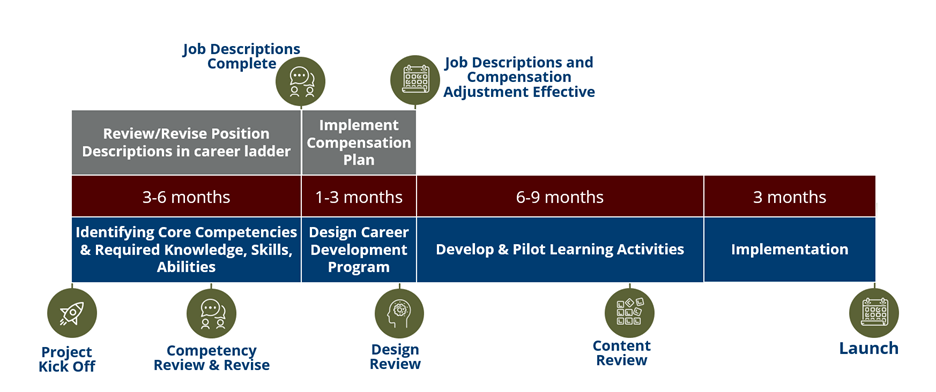Career Development Programs
Career development programs recognize that not all university employees desire supervisory responsibilities or a leadership role. Thus, career paths afford employees the opportunity to develop expertise within their profession.
Program Development Process
Identify Critical Roles
Critical roles can be divided into leadership and mission-critical types. The following mission-critical positions have been identified across the university:
- Academic Advisors
- Business Coordinators
- Veterinarian Technicians
- IT Professionals
- HR Generalists
- Police Officers
- Communication Specialists
- Facility Coordinators
Create Career Paths
Career paths support the progressive development of core competencies for the different critical roles across the university. Career Paths are dependent upon the existence of easily recognizable career ladders within each job family. Positions within the career ladder have job descriptions which reflect the core competencies needed and list internal career development programs and experiences as preferred. Upper-level positions within a career ladder emphasize experience, expertise, mentoring, and coaching.
Create Career Development Programs
Core competencies for career paths are established within a competency map which identifies the learning objectives and learning activites included in career development programs. Career development programs might enable employees to earn professional certification or continuing education credits.

Development Timeline: Major Phases
The program development process can take between 12 to 24 months depending on a variety of factors. A program development project kicks off with Phase 1 which includes two scopes of work:
- Review/Revise Position Descriptions, guided by a Classification and Compensation subject matter expert
- Identifying Core Competencies and Required Knowledge, Skills, and Abilities, facilitated by an Organization Development Consultant
The program development project transitions to Phase 2 once Job Descriptions and the Competency Map are approved. Phase 2 also includes two scopes of work:
- Implement Market Compensation Plan, guided by a Classification and Compensation subject matter expert
- Design Career Development Program, guided by an Instructional Designer
Phase 2 is complete when new job descriptions and corresponding compensation adjustments are effective; and, the program design is approved. In phase 3, learning activities that accomplished the learning objectives outlined in the competency map are developed and piloted. The fourth and final phase focuses on implementation, confirming and coordinating the needed delivery logistics. The program development project concludes with the launch of the new Career Development Program.